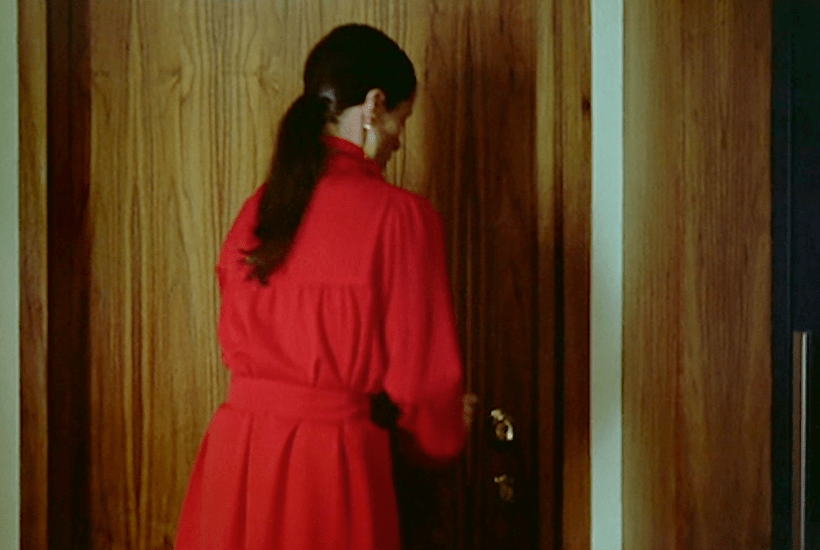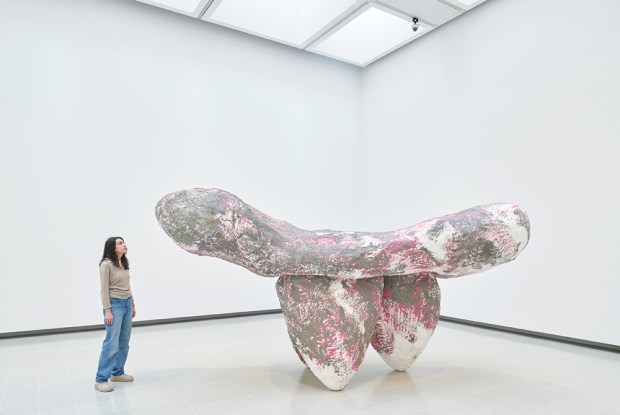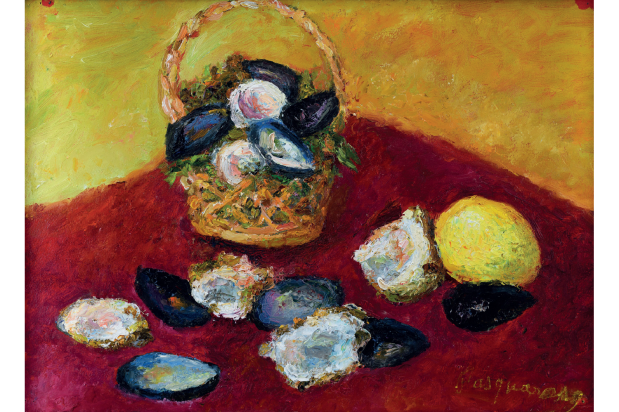Sliding doors may change your life, but there’s no mystery in their transparency. A hinged wooden door is another matter; you’re never quite sure what’s behind it.
Christian Marclay has a thing about doors; not an obsession, he insists, just a general interest ‘in things we don’t pay much attention to’. For the British launch of his new video montage ‘Doors’ he has filled the ground-floor gallery of White Cube Mason’s Yard with doors picked out of London skips, sawn up and reassembled into what could be taken for minimalist sculptures if the knobs, knockers, locks and hinges weren’t still attached: ‘I don’t want to mess about with their “doorness”,’ he explains. A solid wooden Victorian door is carved into a cross, while modern veneered doors are chopped and stacked in blocks, exposing their filling. ‘In cutting you discover what’s inside the door,’ he says.
In the film downstairs you discover what’s behind it, or you would if Marclay hadn’t messed around with its ‘filmness’. Like ‘The Clock’, the work that won him the Golden Lion at the 2011 Venice Biennale, ‘Doors’ is a collage of sampled clips from different films. Unlike ‘The Clock’, which had a surprisingly easy birth for a 24-hour film you can tell the time by, ‘Doors’ has been ten years in gestation. Marclay gave up twice. With clockfaces it was easy to jump cut from one image to the next, but doors presented particular problems of continuity. Was the hinge on the left or the right? Was the door opened by pushing or pulling, and how fast?
Without the inexorable passage of time, he could at least run the clips in any order. Genres switch from noir to comedy in the blink of an eye and sequences of non-sequiturs are cleverly paced, with hectic chase scenes intercut with interludes of ominous calm. It’s noticeable how actresses are typically filmed quietly opening doors into domestic spaces, while actors tend to burst through doors with guns. Close-ups of keys being turned, bolts drawn, locks picked and keyholes peered through – accompanied by the creaking of hinges and the clicking of latches – heighten the tension.
Repetition is employed to surreal effect. Brigitte Bardot pops up at intervals to open a door with an ‘Oh, pardon!’ to a series of actors in different films, including John Wayne in Rio Bravo; a man returns repeatedly to the same office to pick up a packet with the line: ‘I forgot the money’; a young woman runs down a hotel corridor pursued by a posse of shrieking girls. Most of the time I had no idea what film I was in, but I’m no film buff and neither is Marclay; disorientation adds to the fun. The video’s 54-minute loop is designed, he says, to replicate the gallery experience of artists’ videos where you have no way of knowing at what point you came in and ‘wonder how long you’re going to be stuck there. It gives video a bad name’. When I hear the word ‘durational’ I reach for my sleep mask, but no one would sleep through ‘Doors’ because it’s pacy and fun. ‘Art doesn’t need to be so serious,’ thinks Marclay. ‘Life is funny sometimes.’
Young Dutch artist Hendrickje Schimmel’s first solo UK institutional exhibition, Soft Acid, at Camden Arts Centre last year had its funny side, but the 33-year-old’s current show Ladders, at Bethnal Green gallery Soft Opening, is more serious. Operating under the alias Tenant of Culture, Schimmel – who has a background in fashion – has acquired a reputation, like Marclay, for sampling. In her case unstitching and rehashing handbags and trainers into monstrous caricatures of fashionable footwear that question the desirability of walking around with things on your feet streamlined to resemble steam irons or superyachts.
Now she has turned her attention to the trend for artificially aged clothing, purposely pre-torn, slashed and frayed by the garment industry to cater to the ‘Avant Apocalypse’ market. At the luxury end the look can cost a fortune – Balenciaga’s beaten-up ‘Paris’ sneakers launched in a limited edition last year for $1,850 a pair. At the affordable end it’s cheap as chips. For Schimmel’s new ‘Haul’ series, instead of sourcing clothes from eBay and charity shops she has been ordering high street brands online and slashing them through their unopened plastic packaging, suturing their gaping wounds with tape. A pair of monumental knitted hangings titled ‘Sabotage in Acrylic’ is perforated with repeating patterns of designer holes and ladders made by specially programmed factory machines, but it’s Schimmel’s handmade – or unmade – work that is most effective. For her ‘Drawn’ series she has pulled the threads from canvas tote bags to create designs of old-fashioned openwork embroidery that render the objects beautifully fragile but useless as bags. Her work used to look like a spoof of fashion; now it looks like art.
Got something to add? Join the discussion and comment below.
Get 10 issues for just $10
Subscribe to The Spectator Australia today for the next 10 magazine issues, plus full online access, for just $10.
You might disagree with half of it, but you’ll enjoy reading all of it. Try your first month for free, then just $2 a week for the remainder of your first year.














Comments
Don't miss out
Join the conversation with other Spectator Australia readers. Subscribe to leave a comment.
SUBSCRIBEAlready a subscriber? Log in